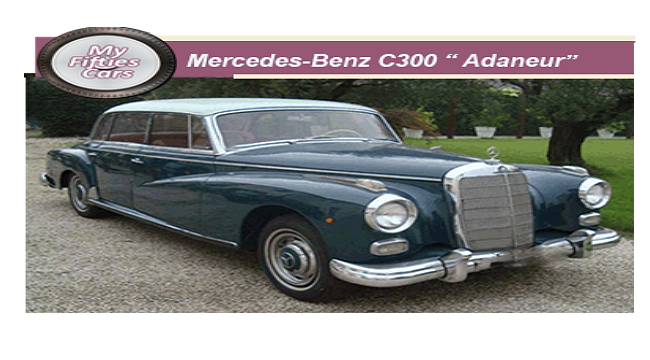
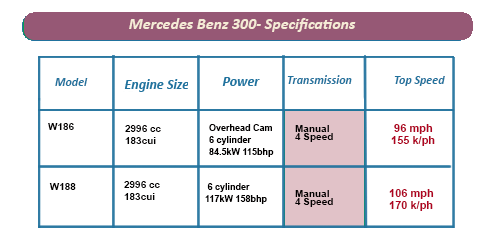 Those attending the show in Frankfurt had to take a second look at what Mercedes had on offer that year, that was particularly impressive just six years after the company had pulled themselves from the ashes of World War Two.
The 300 series, undoubtedly the " top of the range" for Mercedes in the Fifties stood out for the massive chrome mouldings around the headlamps, with separately-mounted auxiliary lights above the bumper as much as for its modernistic one-piece curved windshield.
Dominating the front of the 300 was the large grille in the now familiar tight mesh pattern in traditional upright Mercedes style, topped by the iconic Tri-Star emblem.
Those attending the show in Frankfurt had to take a second look at what Mercedes had on offer that year, that was particularly impressive just six years after the company had pulled themselves from the ashes of World War Two.
The 300 series, undoubtedly the " top of the range" for Mercedes in the Fifties stood out for the massive chrome mouldings around the headlamps, with separately-mounted auxiliary lights above the bumper as much as for its modernistic one-piece curved windshield.
Dominating the front of the 300 was the large grille in the now familiar tight mesh pattern in traditional upright Mercedes style, topped by the iconic Tri-Star emblem.
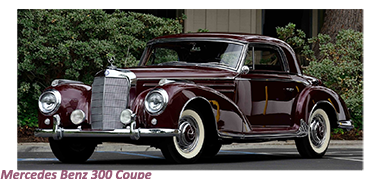 Extended parking lights sat on top of the fenders that neatly faded into the front doors (which hinged at the front), passing alongside an expansive hood.
Extended parking lights sat on top of the fenders that neatly faded into the front doors (which hinged at the front), passing alongside an expansive hood.
 Powered by an overhead cam six-cylinder engine with aluminium cylinder head displaced 2996 cc 183 cubic inches capable of generating 158 bhp, the Mercedes Benz 300 series was fitted four-speed transmission synchronised in all forward gears, controlled by a column gear shift lever.
Powered by an overhead cam six-cylinder engine with aluminium cylinder head displaced 2996 cc 183 cubic inches capable of generating 158 bhp, the Mercedes Benz 300 series was fitted four-speed transmission synchronised in all forward gears, controlled by a column gear shift lever.
![]()
Standard 300 equipment included dual fog lamps, backup lights, a triple horn, electric clock, lighter, locking glove box, and octane-rating compensator switch. Interior features included door armrests, retracting centre rear armrest, dual sun visors, and front door pockets.
Each open style offered 2+2 seating with fold-down rear seats and rolled/pleated leather upholstery.
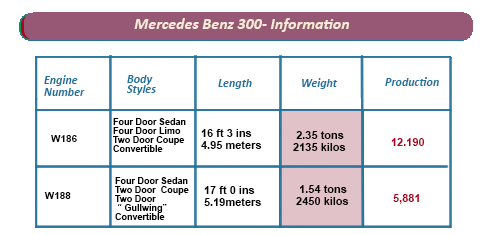 Customers had a choice of wood veneers: either straight-grain or burled walnut. Fitted luggage was available, too.
Customers had a choice of wood veneers: either straight-grain or burled walnut. Fitted luggage was available, too.
Two spare tire wells sat in the trunk.
On the dashboard was a control for ignition timing. Standard equipment included a signal-seeking radio, no-glare mirrors, vacuum-assisted brakes, backup lights, reclining seats, and windshield washers.

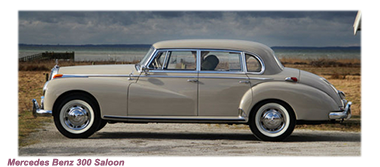 The four-door luxury saloon version of the 300 soon earned itself the title of the " Adenauer" in the name of Konrad Adenauer, the first post-war Chancellor of West Germany from 1949 to 1963,
Adenauer, a much loved and respected figure, was primarily responsible for rebuilding the country's economy.
The four-door luxury saloon version of the 300 soon earned itself the title of the " Adenauer" in the name of Konrad Adenauer, the first post-war Chancellor of West Germany from 1949 to 1963,
Adenauer, a much loved and respected figure, was primarily responsible for rebuilding the country's economy.
![]()
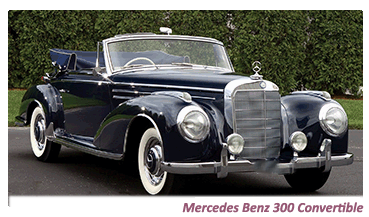 A specially tuned 240-bhp (SAE) version of the 300 sedan's 2996-cc overhead-cam engine provided the power, for the 300S Roadster, which was becoming the first production car fitted with fuel injection, developed especially for Mercedes-Benz by Bosch.
A specially tuned 240-bhp (SAE) version of the 300 sedan's 2996-cc overhead-cam engine provided the power, for the 300S Roadster, which was becoming the first production car fitted with fuel injection, developed especially for Mercedes-Benz by Bosch.
 To complete the 300 series Mercedes-Benz released a four-door super roomy convertible, equipped with landau bars while its convertible top could be rapidly and neatly folded away in a large rear storage compartment.
A comfortable five-seater, three people could comfortably fit in the back seat, although only when the centre armrest folded away.
To complete the 300 series Mercedes-Benz released a four-door super roomy convertible, equipped with landau bars while its convertible top could be rapidly and neatly folded away in a large rear storage compartment.
A comfortable five-seater, three people could comfortably fit in the back seat, although only when the centre armrest folded away.


